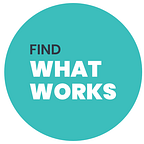Building an Experimental Government
It has been a couple of months since our relaunch event of Experimentation Works (EW) on February 24th, 2022. We called this event “Building an Experimental Government” as we spent time reflecting on how experimentation has grown in the federal public service and where it’s heading next.
As our team moves into a steady pace of identifying and supporting new experimental projects, we thought it would be a good moment to provide an update to our community and unpack some of the ideas that have stayed with us since the launch event.
EW service model
For those following this space, most of you know by now that we have evolved the EW model from an annual cohort of projects to a more flexible and on-demand service. Since our relaunch, we have received EW requests from seven teams across the federal family. The experiments proposed touch on a wide range of policy areas, including housing, youth employment, lived experiences in healthcare, hybrid work, and employee health and well-being.
So far, we have had four projects move on to matching with an expert advisor. Most of the other projects were in early stages and have been directed to other resources to refine their experimentation plan before bringing in expert advice. Over the next few months, our team will be working to promote the EW service to other areas of government and to streamline our guidance materials for teams who are just starting out on their experimental journey.
5 years of progress
Of course, the type of experimentation we are talking about is not new to the Government of Canada. It has been just over five years since the 2016 Experimentation Direction to Deputy Heads was released by the Treasury Board Secretariat and the Privy Council Office. We were pleased to see the continued enthusiasm for policy experimentation at our event and to reconnect with our community to celebrate how far we have come.
The 2016 Direction was a clear call to action, emphasizing that “ethical and rigorous experimentation is central to the Government’s focus on evidence-based policy-making, results and delivery.” Teams across government have responded to this Direction with spirit. It is remarkable to see the progress reflected in our Management Accountability Framework data. In 2020, 91% of federal departments and agencies committed resources to experimentation, 88% were running experiments and 65% had a framework in place for experimentation.
With more targeted resources dedicated to experimentation, we’re seeing an increase in the number of experimental projects across government. We’ve also seen the creation of governance bodies and specialized units for innovation and experimentation at the department level. What was once side-of-desk, or limited to scientists, has grown into a deliberate practice of innovation and ethical experimentation in many parts of government.
So, given the progress made, is experimentation still necessary?
We think yes. There are still so many areas of Canadian policy and service delivery where we don’t know what works best. To take just one timely example, we’re all still finding what works best for managing and working in hybrid teams. And it’s not just about running the experiments. It is also critical to ensure that senior leaders are using experimental evidence in the decisions they make.
The need to keep experimenting was also repeatedly stated in our panel discussion at the launch event. We were joined by Nick Chesterley, Director of Strategic Policy and Experimentation at the Treasury Board Secretariat, and by Sasha Tregebov, Director of the Behavioural Insights Team Canada. It was a rich discussion full of reflection, hope, and a reminder that while we have made great progress, we are still only scratching the surface of what experimentation has to offer. Below are a few of the moments that have stayed with us since the event.
Next time your team brings you three great ideas, try them all.
When asked what managers and executives can do to support more experimentation, Nick’s answer was simple. Next time your team brings you three great ideas, see if you can find a way to try them all. Senior leaders can often feel pressure to make decisions and provide clarity to their teams. But sometimes, the best thing we can do is create space for experimentation and learn from doing.
This takes courage. It requires us to admit, as individuals and as teams, that we don’t always have the answers or know what will work in advance. But what better way to find out than to test our best ideas, in a smaller way, before rolling them out or making more permanent decisions? This reflex is what we often refer to as an experimental mindset. It is the impulse to keep asking questions, testing solutions, and finding smart ways to measure and compare our impact.
The misconception of perfect data… and experiments.
Maybe the above suggestion doesn’t sound like a perfectly designed experiment and of course it isn’t. But as Sasha raised in our panel, we need to overcome the myth of needing perfect experimental designs or data to run experiments. The reality is, we make decisions based on imperfect information every day. Even imperfect data or simple experiments can generate insights we didn’t have yesterday. What matters is to start somewhere and to be upfront about any limitations. As long as we continuously strive to improve our level of evidence, we will always end up knowing more than we did before.
So, with that, we continue to encourage you to keep trying, testing, and asking new questions. And if you need a helping hand along the way, please reach out to our GC Experimentation team or submit a request to the EW service. We are here to help, and eager to see what the next five years of experimentation will bring to the Government of Canada.
Author: GC EXP Team
